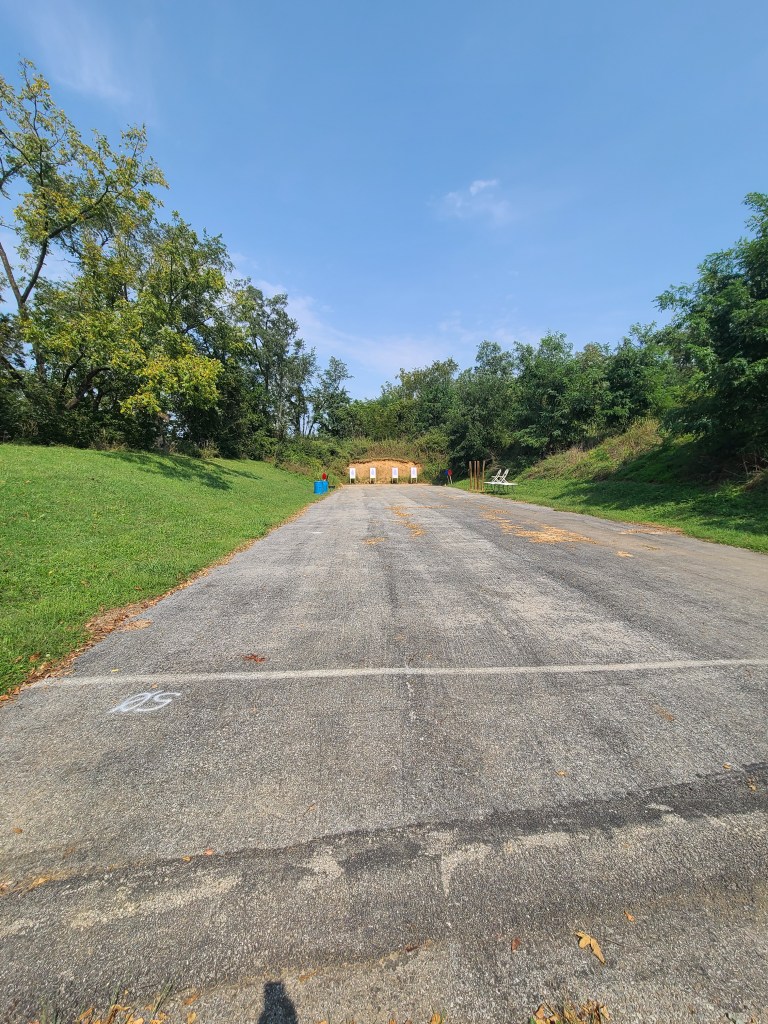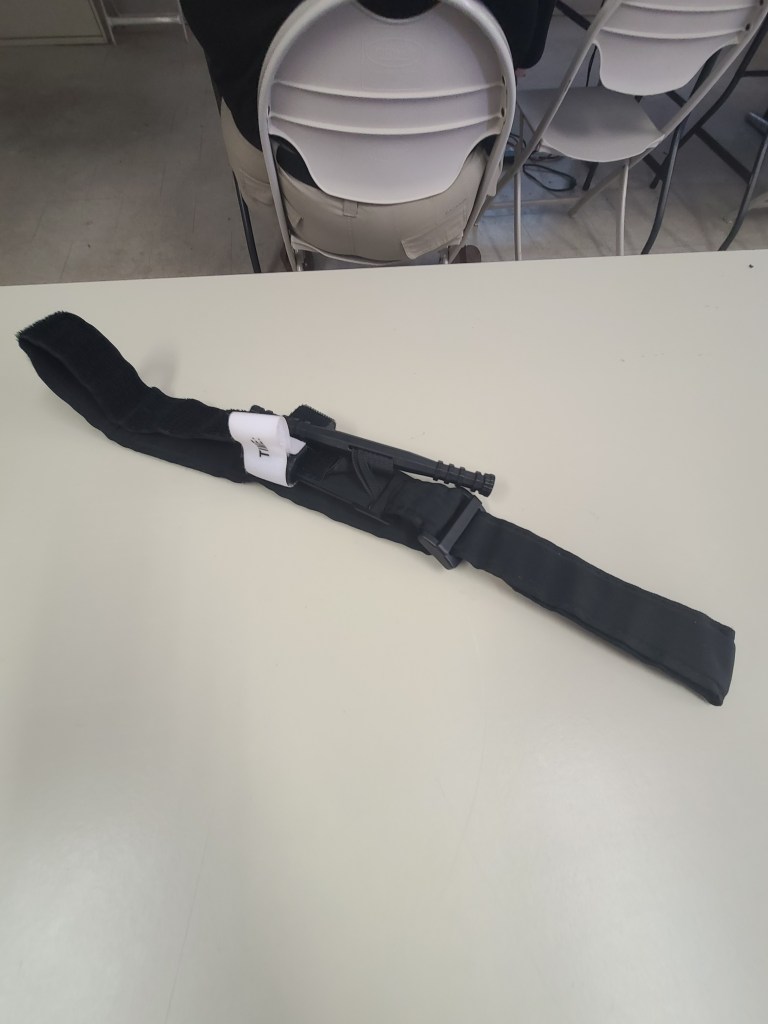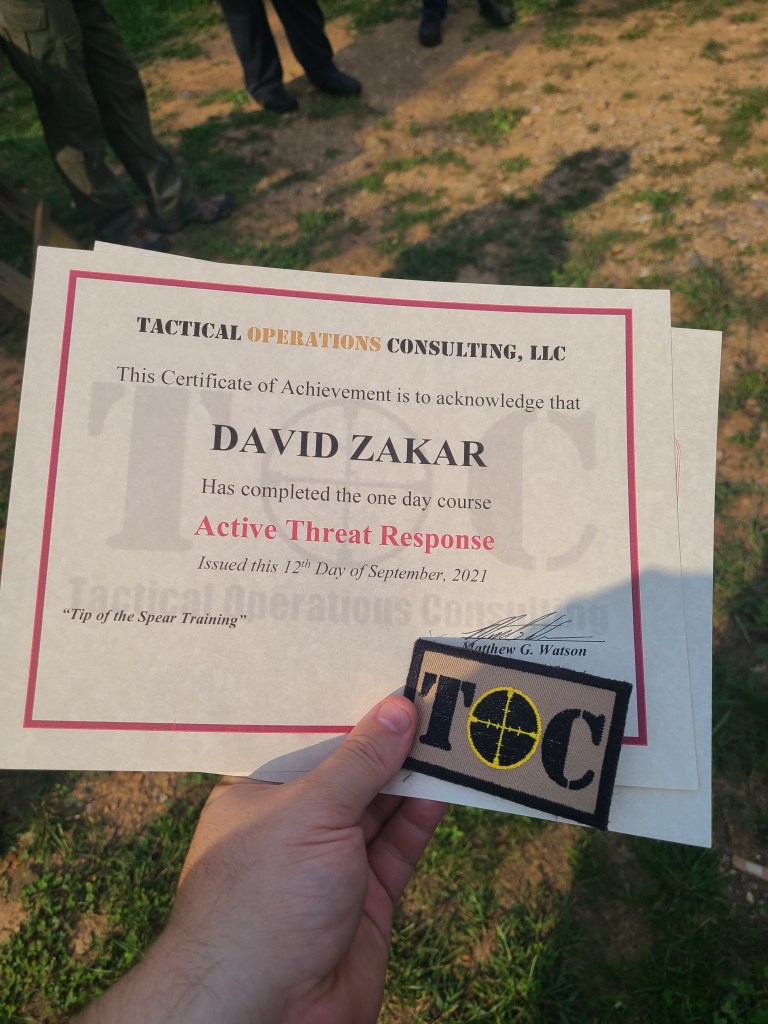Ever since I started coaching a youth shooting sports team, the medical aspect of shooting has loomed a little larger in my consciousness. While we run very safe practices, life comes at you fast, and you need to be prepared for the worst eventualities. It was serendipity, or at least a nice coincidence, when I saw that TOC was offering a class that combined active threat management, Stop the Bleed, and some shooting. When another class with them got canceled, I applied the payment to their Active Threat Response class.
What did I think? Read on!
Disclaimers of Sources of Bias: No bias disclosures required, except that I regard the instructor, Matt Watson, as a friend. I paid full freight, and gladly.
Class Title: Active Threat Response.
Class Description: From the website:
This one-day course is in response to the increase in active shooter incidents around the country. Students will review previous incidents and debrief lessons learned. Those lessons will be applied in live fire exercises on the range. This course is designed to give citizens some tools to respond to active threats. The topics that will be covered include:
- Situational Awareness
- Creating a Plan
- First Aid
- Legal Responsibilities
- Shoot/ No Shoot Scenarios
Cost: $150
Round Count: Listed round count was 300. Actual round count was 150-200.
Instructors: Matt Watson was the lead instructor. His bio on the website is bizarrely understated, but he was a medic in the Army and continued to build expertise in tactical medicine and active shooter incidents throughout his law enforcement career.
I’ve said this before, but I’ll say it again: I really enjoy Matt as an instructor. He has that magic mix of expertise, humor, and no ego that make him a superb teacher. Even when things go wrong on a demo – and that happens to any instructor who demos – he handles it well and doesn’t lose his cool. Definitely an under-appreciated gem in the local instructor cadre!
He was assisted by “Josh”, who was the AI. Josh was more of a support AI than a co-teacher AI, but that’s fine. This made the instructor to student ratio 1:4, which is pretty good in my book.
Location/Date: The class was held on September 12, 2021, at the Jefferson County Sheriff’s Range in Kearneysville, WV. This combination of timing and location is awesome for me – it’s not that far away, and starting at 9AM means I’m not trying to get out of the house at some crazy early hour.
The range is not necessarily as majestic a facility as you might imagine, but it was adequate for the class. It is basically a 50yd five lane, one-way range on black top, in the midst of a small berm valley (which provided shade, at least in the morning). TOC had some tents and tables out for students to stage their gear and stay out of the sun. Water was also provided (and I partook of a couple bottles).
Unlike in previous classes I’ve taken with TOC, we used the classroom double wide trailer for the first half of the class. This was wonderfully air conditioned and spacious. Two thumbs up from me. The well-maintained porta-potty is right next to it.

Weather: The temperature hovered around 85-90f, but we didn’t get a lot of direct sun, and the humidity was on the low side. I’d rate it as a pleasant day.
Equipment Details: I brought my usual combination of Blade-Tech double belt, drop-offset Safariland GLS holster, and some mag pouches.
Riding in the holster was my ported P320 X5 Legion with Deltapoint Pro. The ammo was my 147gr reloads. Unlike my last outing with TOC, I had zero failures of any sort.
Preparation Drills: I have been back in full swing with shooting competition on a regular basis, and between that and regular classes and practices, I am probably as on the ball with a pistol as I’ve ever been.
Author’s Previous Experience: Civilian with no military or LEO background. Have shot some competition, but no accomplishments worth bragging about. Training junkie since April 2018, and have averaged a class a month since then. I am OK with a carbine, pretty good with a pistol, and just average with a shotgun.
Class Demographics: There were eight students in the class, which I think was a surprisingly small number given how broadly applicable the subject matter was. I am not sure if this was the class limit, or if the start of the school year eroded enrollment.
It was all men except for one woman. I think there were maybe one or two LEOs, but everyone was else was Joe Civilian. Skill level varied wildly. About half the class was what I’d put in the category of “very proficient”. The other half of the class… perhaps not. And that’s OK. Matt spent the time needed to help get them up to where they needed to be. His expertise in teaching fundamentals was demonstrated in crystal clear fashion
I saw a lot of smaller pistols out there, such as the Sig P365. And, largely, they were correlated with lower performance. I think it’s commendable to try to use your carry pistol as a class pistol, but the takeaway probably could also be “is my performance with this sort of pistol good enough that I should be carrying it?” I regularly use a pistol that’s 2.7lbs, and I agree that this would probably make for an unpleasant daily carry. But I could swap my grip to a much lighter XFull grip, and I severely doubt I’d be turning in a terrible performance… perhaps that’s an experiment to run sometime.
TD1 (morning): After arriving at the class location, we were ushered into the classroom, and presented with a loaner CAT training tourniquet. Things kicked off with the usual round of intros; the students were universally interested in the medical portion of the class, and the shooting was barely mentioned at all. I rather suspect there’s a big untapped market for civilian non-LEO tactical medicine classes, and I’m interested to see who’s going to finally try to make it their thing for the long-term.

The slide deck began with a brief on active threats (which includes active shooters, but is not necessarily limited to them). Some topics included:
- What is an active shooter?
- Discussion of the statistic – how many and where
- Insider vs external threats
- How to balance welcoming environment with security – soft targets. Schools, hospitals, hotels, and events
- What to expect in a mass casualty event
- Description of typical active threat person – but realize that assuming characteristics may get you killed
- Review of past incidents
- What can we do? Run, hide, fight
- Securing doors… think belt usage to secure door knobs and closure mechanisms
- How to discuss the topic with family
- How to spot an armed threat
- Duty to act, or lack thereof.
- How to be a good witness and call the police
If that seems like a lot, it was. This class was tied with the long-distance shooting classes for the quantity of notes I took, and it’s really hard to overestimate how much information Matt gave us in the space of an hour and change. I will say that not much of it was a surprise, but having an expert in the field to ask some questions to was much appreciated.
Matt is a great presenter. He made the material interesting, and while he treated it with the right level of severity, he kept it humorous enough that you didn’t quite get depressed.
We had a short break around 10:30AM, at which point we launched into the second portion of the classroom learning: the Stop the Bleed course.

I’ve never taken StB before, but it has been on my radar for a long time, and recent life commitments have made it an even bigger priority for me. I bring this up to basically say that I am not really in a position to judge whether this was a good StB delivery or a bad one. I thought it seemed really good, but I think it’s important to give that disclaimer.
The Stop the Bleed slide deck was well constructed. Certain parts of it were rather graphic, but it turns out that the sorts of injuries that you apply tourniquets and wound packing to aren’t all that pretty in real life. It walked us through the basics: Alert, Bleeding, and Compression.
Besides, the raw information given in the deck, we practiced using tourniquets and wound packing. I liked that the tourniquet use was so centered around self-application – not necessarily because I think this is the most likely use in my life, but because putting it on one-handed is the hardest way to do it. We had the option to try applying chest seals, but spending time applying stickers to ourselves didn’t seem like a winner to anyone else.

There was also a great discussion on gear, including various types of hemostatic gauze, IFAKs, and nasopharyngeal airways (NPAs). I definitely walked away from that portion of the slides thinking about what I wanted to change with my prep.
This block went on for a solid two hours, at which point we broke for lunch around 12:30 PM.
TD1 (afternoon): We reconvened on the range at 1:30PM – it was time to start the more dynamic, shooty part of active threat response! Shooting was run in two relays of four students.

After forming up on the line and getting our pistols out, Matt ran us through a series of draw-and-shoot drills. These were simple diagnostic drills that tested basic competence with putting shots into small areas (3×3-ish square, for example) at 3 yards, combined with the odd transition or controlled pair. This is standard stuff for open enrollment classes to make sure people can draw safely and put rounds mostly where they need to go. The class was about 50/50 on that score. Half the class demonstrated some pretty remarkable accuracy (albeit not always a lot of speed), but the other half really struggled to put bullets where they needed to go. Matt spent the time necessary to get them up to standards, and while I’m not sure I would call them expert marksmen by the end of class, the situation was good enough that they’d get something out of the later drills.
Our next skill to drill was movement while shooting a somewhat larger area of the paper target. This was a straightforward “walk forward, walk backward” drill. Matt had the off-the-line relay act as the movement spotters for the relay on-the-line, and this worked quite well. The way this taught was not unique in the sense that it’s what I’ve heard almost everywhere else “walk normal, take small steps, learn to time your shots to your sight movement”. That said, shooting while moving at someone else’s pace, not your own, is a challenge, and does force you to work those fundamentals a little harder than if you could move as fast or slow as you cared to.

This was followed by a set of drills that started from the seated position, but ended in the standing position, shooting steel targets while both seated and standing. I guess the idea here is that you may have to draw and engage while seated, but then try to get off the X while engaging with the threat. While this sounds simple, there are a fair number of considerations for safely drawing and not muzzling yourself, smacking the table, falling off your chair, etc. Matt built on the complexity by introducing a forward barricade that you had to lean around while sitting.
Continuing on the theme of building skills, Matt had us weave through a series of barricades while engaging steel targets, going both forwards and backwards. The premise was that you were moving through a crowd. I sorta forgot the barricades were supposed to be real people on the way forward; if I were to suggest an improvement, slapping no-shoot targets on the barricades to reinforce the scenario a little further would have helped. I feel like I’d be less likely to point my gun at a civilian picture than a bare barricade.
The final drill of the class was an interesting “push back” drill. You started with an instructor smacking you with a large boxing pad, which you would then push back against, turn, draw, and shoot a pair of steel targets. I have to admit some initial concern that someone would skip that whole turn step and vent the poor instructor, but everyone seemed to get the message, and the drill was conducted safely. The point of the drill was to get you used to the premise that you might have to push someone out of your personal space before pulling your gun. This was a very tiny taste of what you’d presumably get out of an ECQC class, but it worked well, and it was a first for me.
TOC ends all their classes with a patch competition. In this case, it was a mirrored head-to-head competition where students competed on a drill that involved seated, standing, and leaning elements. I’m not sure it was perfectly thematic with the active threat response theme, but it did test student performance.
I’m pleased to say that I finally won my first TOC patch at this class! The final round of competition was tough, but I made it happen.
Class Debrief: We put away the targets and barricades, and gathered up to receive certificates and handshakes. You got both the standard TOC certificate and a Stop the Bleed certificate from this one, so it was
Conclusions: I really enjoyed the class. Perhaps the first half more than the second half, but only because the material in the former was a lot more novel for me. I think there’s some natural tension between doing an open enrollment class and what you can really do with practicing the advanced shooting you might need in an active threat situation. I was having IDPA flashbacks from all the seated shooting, but the moving and shooting was great, and really exercised that skill set – a skill set I don’t utilize as much as I should. Matt is a really talented instructor, and does not get the recognition I think he should.

I’d recommend the class, doubly so if you want or need Stop the Bleed certification. The shooting is not going to be revolutionary to anyone who’s done much advanced shooting, but as with all else, you’re going to get as much out of it as you put in, at least in terms of challenging yourself. Less experienced shooters will probably find it more of a learning opportunity. However, the medical portion is easily worth the cost of admission all on its own, and it was invaluable. I also thought the module on active threats was really good, and definitely has changed the way I think about some public spaces I inhabit frequently.


One thought on “TOC Active Threat Response AAR”